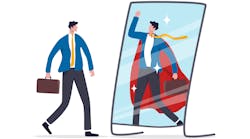Latest from Columnist
Staying safe begins when you load up and get in the truck and (I hope!) you hook up your safety belt.
I had the seat belt habit pounded into me by my old boomer line foreman, Ellis Nelson, while working for Northwestern Bell in Minneapolis. Ellis would catch me "sittin’ on the belt insteada usin’ em," and if you’ve ever felt the wrath of a boomer line foreman in chew mode, you’ll know why wearing them became habit. Because of this safety lesson, I lived through a terrible car accident in 1991. Lesson learned!
Working line crew is your basic safety training ground. From day one, working as a grunt for a man aloft, safety glasses, gloves, hard hats, boots, and proper clothes, are a must. This apprentice job requires that you learn to properly and safely handle heavy equipment, strand stresses and strains, cables and drops. Cutting a wire without relieving the strain can mean a trip through the air or down a telephone pole in a second.
Trenchers, back hoes, boom trucks, and myriad other heavy equipment can, in a quick moment, remove or damage appendages, slice, scrape, and otherwise make a bad day for any lineman who drops his guard.
In most telephone companies all technicians received, and continue receiving, extensive safety training in all aspects of the job. And survival lies in following the rules.
Bottom line: safety is up to you. Companies require that you be taught safe processes and procedures — but they can’t look over your shoulder every day.
Remember: working in a safe manner cannot only save you from serious injury but it can also save those who work with you or those who are nearby when you are working.
InvisiLight® Solution for Deploying Fiber
April 2, 2022Go to Market Faster. Speed up Network Deployment
April 2, 2022Episode 10: Fiber Optic Closure Specs Explained…
April 1, 2022Food for Thought from Our 2022 ICT Visionaries
April 1, 2022SAFETY TIPS
A bit of thought is required for each specific task performed on a daily basis, and it’s better to pre‑plan each task with an eye to safety and avoid surprises.
Safety Headgear, or Hard Hats
Some safety precautions are obvious. Hard hats, for example, are designed to act both as a shield and a shock absorber to protect against head injuries. A hard hat also provides protection against electric shock in case of accidental contact with electricity. But the use of safety headgear in no way reduces the need for good job planning and observing the safety requirements the task demands.
Most companies require that your hat goes on when you open the truck door to begin working. If that isn’t a blanket requirement, safety headgear should be worn whenever engaged in outside plant or installation and repair work whenever you are subjected to conditions that could result in head injuries from moving or falling objects, striking against stationary objects, or when the possibility of electrical shock exists. In other words, pretty much all the time! Watch your head friend — you’ll keep it longer.
Potential Electrical Hazards
Be sure to look for potential electrical hazards before climbing or working in joint use plant. It is imperative that you recognize, test, and eliminate, the possibility of electrical shock before exposing yourself to a potential electrical hazard.
Eye Protection
Eye protection is simple enough. Use eye protection whenever performing, observing, or supervising, a work operation where there is any possibility of injury to the eyes.
There are 2 types of eye protection: Regular Protection, and Special Protection.
Regular Protection consists of frontal eye protection against flying or moving objects.
Special Protection consists of side, as well as frontal, eye protection from flying or moving objects and irritating liquids dust and splashes. We do very good when it comes to Regular Protection, but seem to drop the ball when it comes to Special Protection. Perhaps it feels awkward to some but it’s like seatbelts: once you become a regular user, you don’t want to work without them.
Back in my splicing days, my helper and I had a splice to wipe on a very cold Minnesota day. It had snowed the night before, and there were several inches of snow on the street.
Since it was very cold, I loaned my new, cutting-edge, ultra-lightweight White Stag snowmobile suit to my helper. After finding the cover with a frost bar, we set up the manhole, started the solder pot, and I went below to prepare the splice for wiping.
Seconds after I called for the solder pot, I heard a double explosion. When I reached the street, I found my helper, and my new snowmobile suit, covered with lead.
My helper had dropped the solder pot in the snow. The solder exploded, ricocheted against the manhole tent, and then washed over my helper. Solder hit his face. He was very lucky — the solder cooled quickly enough so that he wasn’t badly burned, and he did have safety glasses on so he didn’t get solder in his eyes.
I spent the next few minutes peeling solder off my helper. That 4-pound snowmobile suit now weighed 13 pounds — and 30 years later, it’s still shedding flecks of solder. This guy wasn’t safe — he was lucky.
But Lady Luck is fickle.
Body Belts
Body belts are required when working more than 4 feet above the ground on poles, ladders, platforms, aerial lift buckets, cable cars, towers, and terminal balconies. These belts have improved dramatically from the old leather belts, but they require careful periodic inspection. It’s up to you to make sure they are in good condition.
Footwear
Climbers require care and maintenance, but this is directed more to the line crews than to the average ladder technician. It’s both highly dangerous, illegal, and difficult, to climb in tennis shoes, but we all know someone who ignores company policy and wears them on the job. That person won’t be lucky every day — it’s just a matter of time.
Manhole Safety
Manhole safety is of the utmost importance. The process of testing and ventilation has come a long way from the wolf lamp and the sail cloth. New testing systems can indicate hazards ranging from combustible gas and petroleum products, to an unsatisfactory atmosphere.
Even the proper methods of removing and placing manhole covers are important safety procedures. They are very heavy and can result in broken or lost fingers and toes, scrapped shins, and other injuries. Make sure you have your heavy work gloves on, and take your time. Many, if not most, work accidents happen when performing routine tasks because we go about them automatically and don’t think carefully.
Well, back to where we started with me stuck in the side of a 1983 Chrysler, thinking hard about safety. I’m alive, thanks to the telephone industry’s emphasis on safety. Thanks, Ellis. You saved a life.
Like this Article?
Subscribe to ISE magazine and start receiving your FREE monthly copy today!
Signing Off
Stay safe whether in daily life at home or work or while enjoying sports. It’s not just a work issue. I saved my leg from a bad cut by wearing chaps when taking down some trees, and I now wear goggles and ear cover every time I work in the garage or in the yard. It’s a small concession — and you and your family need you to be safe. Contact me for questions or comments at [email protected] or 831.818.3930.









